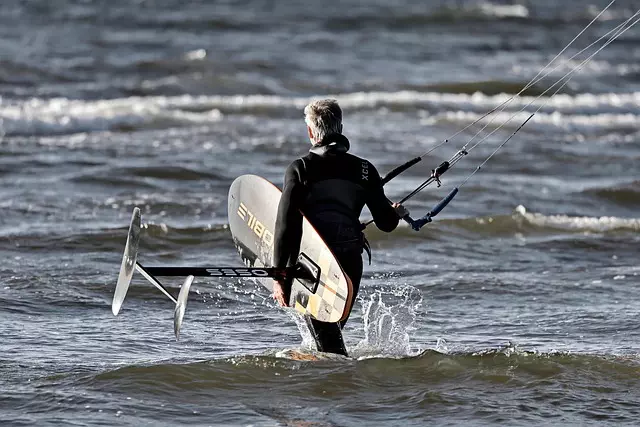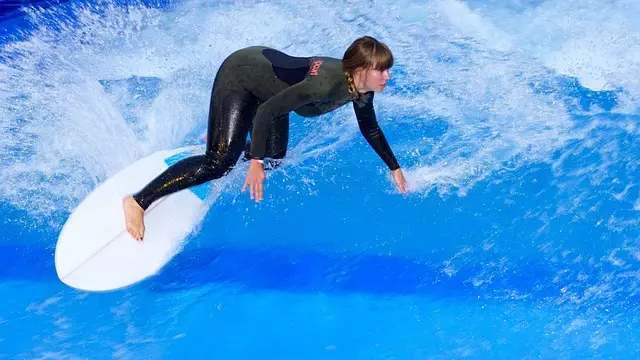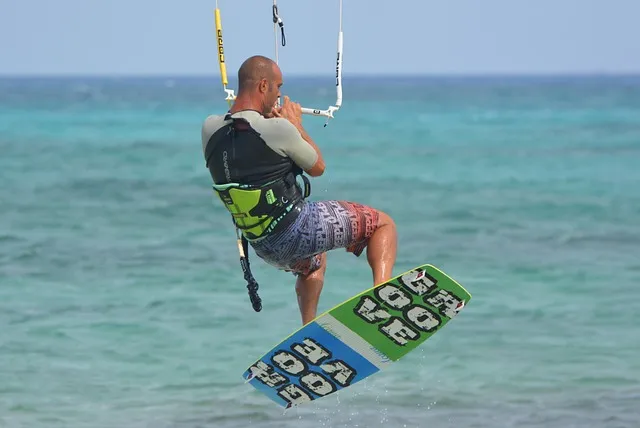Lightweight Foam Core (LFC) is transforming water sports, particularly surfboards designed for beginners. Crafted from advanced polymer blends, LFC offers exceptional buoyancy and maneuverability due to its low weight and high strength. This innovative material enables easier wave-catching and improved control, enhancing safety and enjoyment for new surfers. LFC boards are durable, easy to transport, and more accessible than traditional materials like balsa wood or fiberglass. Choosing the right density and thickness ensures optimal performance tailored to individual needs. Caring for LFC surfboards involves regular cleaning, proper storage, and using protective covers to extend their lifespan. Top brands offer designs prioritizing reduced weight, superior buoyancy, and soft yet durable foam cores, making them ideal for beginners. Lightweight foam core boards are revolutionizing surfing experiences, encouraging more people to try the sport.
“Unleash your inner surfer with the innovative world of Lightweight Foam Core (LFC) surfboards—a game-changer for both seasoned pros and eager beginners. This article guides you through the fundamentals, benefits, and unique aspects of LFC construction. Discover how its superior buoyancy and flexibility make it ideal for beginners, offering a more accessible entry point into the ocean. Explore real-life success stories and learn about top brands leading this sustainable and high-performance revolution in surfboard design, perfect for those seeking an adventure on the waves.”
What is Lightweight Foam Core?

Lightweight Foam Core (LFC) is a cutting-edge material revolutionizing the world of water sports, especially for surfboards designed for beginners. It’s a type of foam with exceptional properties that make it ideal for creating lighter and more buoyant surfboards. Unlike traditional denser foams, LFC offers a unique combination of low weight and high strength, ensuring a safer and more enjoyable surfing experience for those just starting out.
This innovative foam is crafted from advanced polymer blends, resulting in a core that’s not only lightweight but also incredibly rigid and durable. The use of LFC in surfboards allows for greater maneuverability, making it easier for beginners to catch waves and practice their skills without the added difficulty of a heavier board. Its buoyancy provides extra peace of mind, as new surfers can focus on learning techniques without worrying about sinking or losing control.
Benefits of Using Lightweight Foam Core for Surfboards

Lightweight foam core offers a plethora of advantages for surfboards, making it an ideal choice, especially for surfboard designs catering to beginners. Its primary benefit lies in its ability to significantly reduce the overall weight of the board, making it easier for novice surfers to handle and maneuver. This is particularly crucial for those new to surfing, as it allows them to catch waves more effortlessly and focus on learning essential skills without being weighed down by a heavy board.
Additionally, lightweight foam provides excellent buoyancy, ensuring that the surfboard stays afloat with minimal effort. This feature not only aids beginners in their learning curve but also adds to the overall safety of the surfing experience. Its flexibility and resilience make it durable enough for regular use, while its low density ensures it’s easy to transport, making it a convenient option for surfers on the go, especially those who are just starting their journey in the sport.
How Lightweight Foam Core Differs from Traditional Materials

Lightweight foam core stands out compared to traditional materials used in surfboard construction, particularly for those tailored to beginners. The key difference lies in both weight and performance. Traditional materials like balsa wood or fiberglass offer excellent structural rigidity but tend to be heavier, which can make handling the surfboard more challenging for novice surfers. In contrast, lightweight foam core provides a balance between strength and reduced weight, making it easier for beginners to catch waves, maneuver, and maintain stability in the water.
Furthermore, the manufacturing process of lightweight foam core is often simpler and less resource-intensive compared to intricate laying techniques required for conventional materials. This results in lower production costs and, in many cases, a more accessible price point for surfboards designed for beginners who are still honing their skills and discovering their passion for the sport.
Choosing the Right Density and Thickness for Your Surfboard

When selecting a foam core for your surfboard, especially as a beginner, understanding density and thickness is key. Density refers to the amount of material packed into a given space, determining the board’s buoyancy and maneuverability. Higher-density foams offer more stability and better wave-riding performance but can be heavier. Lower densities are lighter, easier to handle, and ideal for beginners learning to balance and paddle.
Thickness influences your surfboard’s flotation and overall ride. Thinner boards are lighter and more responsive, suitable for smaller waves. Thicker cores provide enhanced buoyancy, stability, and better performance in larger waves or rougher conditions, but they’re heavier and less agile. For a beginner surfboard, striking the right balance between density and thickness ensures you get the best of both worlds: easy handling and adequate floatation.
The Process of Constructing a Surfboard with Lightweight Foam Core

Constructing a surfboard with lightweight foam core is an accessible process, making it ideal for those new to surfing who want to create their own board. The first step involves cutting a foam sheet to the desired size and shape using precision tools. This ensures a tailored blank that will form the backbone of your surfboard. Once cut, the foam is meticulously sculpted and shaped to achieve the right thickness and contour, catering to various riding styles.
The next phase includes adding a skin, usually made from fiberglass or synthetic materials, which provides the board’s surface. This step involves careful application and layering to ensure strength and durability. The result is a lightweight yet robust surfboard core, ready for further assembly and finishing touches, making it perfect for beginners looking to craft their own ride and hit the waves.
Care and Maintenance Tips for Lightweight Foam Core Surfboards

Caring for your lightweight foam core surfboard is essential, especially if you’re a beginner looking to make the most of your new ride. Unlike traditional surfboards made from dense materials, foam cores require a different level of maintenance. Start by keeping your board clean; rinse it regularly with fresh water after each use to wash away salt, sand, and other debris. Avoid using harsh detergents or soap as they can damage the board’s finish. After cleaning, ensure you dry the board completely, especially the fins and any waterproof coatings.
Storage is another critical aspect of maintaining your lightweight surfboard. Store it in a cool, dry place away from direct sunlight to prevent fading or warping. If possible, hang it up using a surfboard bag or rack to keep its shape. For beginners, it’s also beneficial to invest in a protective cover tailored for foam core surfboards. This simple step can significantly extend the life of your board and ensure it stays in top condition for years to come.
Why Beginners Should Consider Lightweight Foam Core Boards

Lightweight foam core boards are an excellent choice for surfboard beginners, offering a range of benefits that make learning to surf more accessible and enjoyable. One of the primary advantages is their reduced weight; this makes it easier for newcomers to handle and paddle out to the waves, which can be physically demanding tasks. By choosing a lightweight board, beginners can focus on improving their technique without being bogged down by the board’s buoyancy or stability.
These boards also provide an ideal balance between maneuverability and stability, allowing for better control during turns and maneuvers. This balance is crucial for building confidence as learners progress from wobbly first steps to more fluid movements. Moreover, lightweight foam core designs often prove durable, withstanding the rigors of regular use, which is vital for those just starting their surfing journey who may occasionally encounter a few bumps along the way.
Top Brands Offering Lightweight Foam Core Surfboards

When it comes to choosing a surfboard, especially for beginners, selecting one with lightweight foam core can be a game-changer. This innovative construction offers unparalleled maneuverability and ease of use, making learning to surf that much more accessible and enjoyable.
Several top brands are renowned for producing exceptional lightweight foam core surfboards designed with novices in mind. For instance, companies like Aqua Sport and Surfland offer a range of models specifically tailored to beginners’ needs. These boards feature reduced weight, making them easier to handle, and their soft yet durable foam cores provide excellent buoyancy, ensuring safety and confidence on the water.
Real-Life Experiences: Success Stories of Beginners Using Lightweight Foam Core

Many beginner surfers are discovering the benefits of lightweight foam core in their quest to catch more waves. This innovative material is making it easier than ever for newcomers to hit the water and start shredding. One such success story comes from Sarah, a 20-year-old who had always dreamed of surfing but struggled with the weight of traditional boards. After researching alternatives, she decided on a 6’6″ lightweight foam core board, perfect for her size and skill level. The results? “I felt like I was flying across the water,” she exclaimed, “and I could actually perform turns without struggling.”
Similarly, Mike, a 35-year-old father of two, found that his son’s interest in surfing sparked his own passion. Deciding to learn alongside his child, he chose a lightweight foam core board recommended by a local surf shop. The board’s ease of handling and buoyancy made learning much more accessible. “I was up on my feet faster than I thought possible,” Mike shared, “and within a few weeks, we were both riding waves together.” These real-life experiences highlight how lightweight foam core is democratizing surfing, making it more inclusive for beginners who may have otherwise been intimidated by the sport’s traditional equipment.
